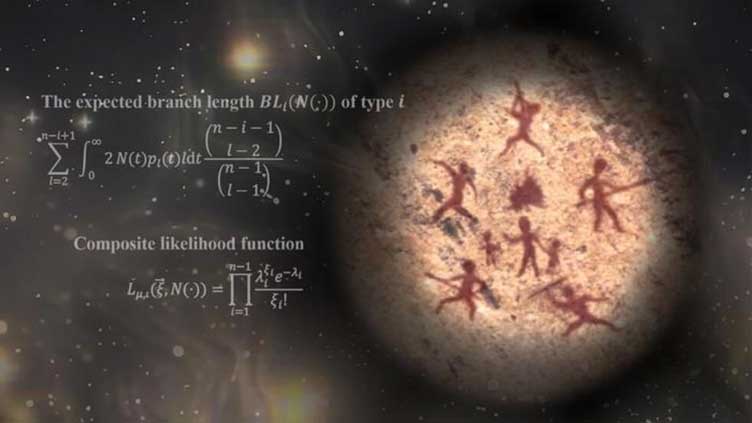Human ancestors were near extinction some 900,000 years ago, says study

WeirdNews
Our ancestors survived in a group of less than 1,300 individuals
New York (AFP) - A study published on Thursday claims that human ancestors teetered on the brink of extinction over 900,000 years ago. Based on a new method of analysis, scientists found that our ancestors survived in a group of less than 1,300 individuals.
While most people nowadays worry about the overpopulation of planet Earth, which is currently hosting more than 8 billion individuals, our ancestors were facing a very different problem.
Using a new technique to analyse genetic data, an international group of scientists suggested that human ancestors suffered a severe population bottleneck starting around 930,000 years ago, in a study published Thursday in the peer-reviewed academic journal Science.
Lasting for almost 120,000 years, this impediment resulted in a drop in the number of child-bearing individuals from around 100,000 to just under 1,300. This drastic population decline could have spelled the end for humankind, preventing our species from ever walking the Earth, the study said.
A mere 1,280 child-bearing individuals
Although previous studies on human evolution put forward hypotheses of population bottlenecks among human ancestors in the Pleistocene era, scientists had trouble finding sufficient evidence due to the lack of human fossil and archaeological records from this period.
Now, thanks to a new method of analysis used to project current human genetic variation backward in time, scientists have managed to estimate the size of the human population during the Middle Pleistocene period.
“The method … called FitCoal, is entirely innovative and has an estimated accuracy of 95 percent,” said two of the study’s co-authors, University of Florence anthropologist Fabio Di Vincenzo and Sapienza University of Rome palaeontologist Giorgio Manzi.
Selecting genome samples from 3,154 people across some 50 population groups around the world, the scientists used FitCoal to trace the genetic baggage back through time to estimate the size of previous populations who possessed the same genetic makeup.
"We need to look at the genetic diversity present in the populations among whom the ancestors of the selected individuals lived. The lower the genetic diversity, the smaller the population," French National Museum of Natural History senior lecturer and anthropologist Céline Bon explained.
By retracing and comparing human genetic mutations, the new analytic method helped scientists reach an estimated population size of 1,280 individuals, which is “the minimum number of fertile individuals required to generate all the genetic variability observed in subsequent generations”, Di Vincenzo and Manzi said.
Scientists thus came to the most likely conclusion of the study: this small group of individuals saved our ancestors from being wiped off the face of the Earth some 900,000 years ago.
'Other groupings of humans'
The study’s estimate of 1,280 individuals, however, does not represent the entire population of human ancestors on Earth at the time.
"We're only talking about reproducing individuals, the estimate doesn't take into account children, elders or those who, for one reason or another, did not reproduce," Bon said. In other words, our ancestors could have lived among larger populations.
Moreover, this type of genetic tracing "excludes all human groups that may have lived at that time but are not our direct ancestors", French National Museum of Natural History research director and palaeontologist Antoine Balzeau said.
Ancient humans that evolved to become Homo sapiens are not the only ones to have walked the Earth, something that the authors of the study have underlined. “In Asia and Europe during that period, there were other groupings of humans, but it is likely that they represent collateral branches of human evolution,” Di Vincenzo and Manzi said.
Climate change a causal link?
Meanwhile the study identified climate change as one of the main factors that drove the spectacular population decline among our ancestors.
"From around 900,000 [years ago], there was a change in climate with a more severe cold period and with less rain in Africa, which could have created desert and isolated population, making surviving more challenging", British Natural History Museum research leader and anthropologist Chris Stringer said.
The challenging environmental conditions led to a demographic crisis among human ancestors, threatening their very existence, Di Vincenzo and Manzi said. Other scientists, however, remain sceptical.
"While these climatic events are indisputable, it's much less clear cut to conclude with certainty that there was a causal link to the bottleneck," Balzeau said.
Pointing to the research methodology used in the study, which is based on an average generation of 24 years, scientists cast doubts on the accuracy of the estimated time period.
“We're not at all sure that a million years ago, the average age for procreation was 24 … and a difference of just a few years can change the time period completely," Bon said.
“The accuracy of the time period is highly questionable, there may be 200,000 years more or less," said Thierry Grange, a molecular geneticist specialising in ancient populations at the Institut Jacques Monod in Paris, in an interview published Thursday in Le Figaro newspaper.
"It's a provocative paper, especially with the idea that such a small number of individuals was able to sustain an entire species for over 100,000 years," Stringer said. For Bon, the study brings us back to one of the most interesting questions of all: "How did Homo sapiens manage to survive?”


